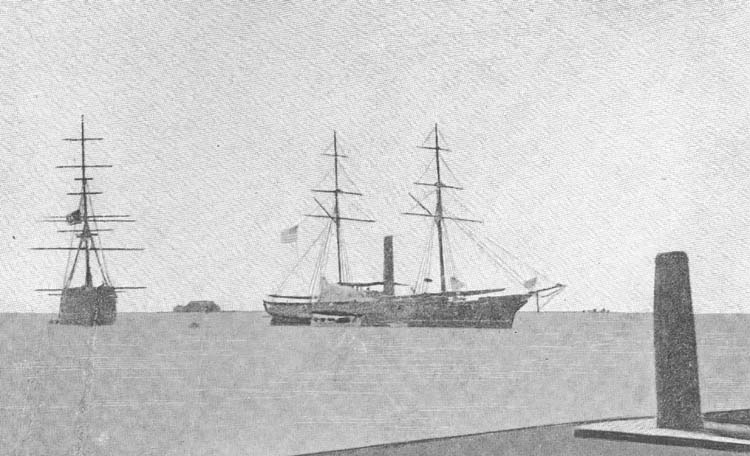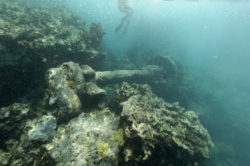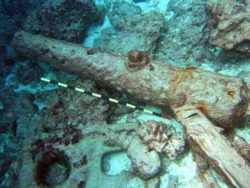
The USS Saginaw’s Journey through the Pacific

A rare photograph of the USS Saginaw, moored near Mare Island Naval Ship Yard. (Courtesy of Houghton Mifflin Company, 1912)
The USS Saginaw, a wooden side-wheeler equipped with both sails and steam engines, was the first naval ship built on America’s West Coast. Its originating shipyard was on Mare Island off the coast of Vallejo, California, and the Saginaw launched in 1859, two years before the start of the American Civil War. During the Civil War, USS Saginaw protected Pacific steam liners along the West Coast from Confederate ship raids from the likes of CSS Shenandoah, the last major Confederate cruiser to ever set sail.
The ship, powered by both sail and steam, represented a transitional period between pre-Industrial and modern methods of transport, and was an integral part of a critical period of American naval history in the Pacific, traveling to Alaska, Japan, and China throughout her lifetime. After nearly 11 years in operation, the Saginaw ran aground on a reef near Kure Atoll in the Northwestern Hawaiian Islands and wasn’t seen again until well over one hundred years later.
On her unknowingly final voyage, Saginaw supported divers for six months during an attempt to develop a coal depot at Midway Atoll, an island southeast of nearby Kure Atoll. However, the operation was not successful. In October 1870, captained by Captain Sicard, Saginaw set sail for nearby Kure Atoll to check for castaways before returning to port in San Francisco. On October 29th, 1870, Saginaw wrecked on Kure Atoll due to heavy swells and dangerous conditions. The crew did not expect to be within range until daybreak, but encountered the island’s reef crest around 3:15 a.m. Unfortunately, even with sails taken in and engines reversed, the ship could not avoid its fate. The reef punctured the ship’s hull and slowly but surely, the ocean overtook the ship.

A NOAA diver floats above one of two large paddle wheel shafts and hub beneath the surf zone of the reef crest at Kure Atoll. (Photo: NOAA NMSP)
The Saginaw’s crew of 93 men lowered the ship’s rescue boats, loading them with rescue provisions they salvaged from the sinking ship, and made their way across the reef to Green Island. Most of the survivors spent two months taking refuge there, except five volunteered who tried to reach the main Hawaiian Islands nearly 1,200 miles away using a sailboat they fashioned from the captain’s 22’ gig. The volunteers spent a month at sea and reached the Hawaiian Islands barely alive. Their makeshift boat capsized in the surf off of Kauai and four of the volunteers died as a result. The lone survivor, Willian Halford, made his way to Honolulu with the help of locals. The Hawaiian steamer Kilauea rescued the crew remaining stranded on the atoll after a total of 68 days by the order of His Royal Highness Kamehameha V. Help arrived for the men sheltering on Green Island on January 3, 1871. For more than 120 years, the Saginaw’s wreck site remained untouched and undiscovered due to the remote nature of and tough conditions of the waters near the Northwestern Hawaiian Islands.

Civil War cannon, a Parrott 30-pdr rifled pivot gun, carried on board the USS Saginaw at the time of her loss in 1870. 10cm increment scale. (Photo: NOAA NMSP)
In 2003, a team of maritime archaeologists found features of the USS Saginaw in the lagoon near Kure Atoll on an expedition. Since the site is in such a hazardous location, they couldn’t stay long. Three years later, in 2006, on a 28-day research cruise, the NOAA ship Hiialakai explored the Northwestern Hawaiian Islands and surveyed the wreck again which greatly helped understand the historic ship and site. The team found dozens of new artifacts including items forged from brass and iron, which have become embedded in the seafloor. Again, open ocean swells and strong winds made it hard to explore and photograph the wreck, but the archaeologists did find important features like the steam engine and ship’s bell; they were also able to retrieve artifacts divers saw in 2003. In 2008, another team returned to the site to continue the survey expedition, mostly to collect site data and video. No site plan has been possible since.
The ship’s bell and deep sea sounding leave both reside at the Mokupāpapa Discovery Center in Hilo, HI and the wreck is protected as part of Papahānaumokuākea Marine National Monument.
